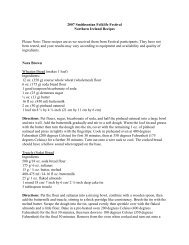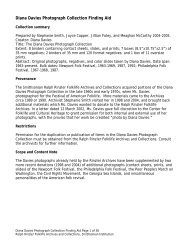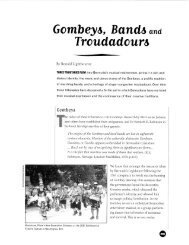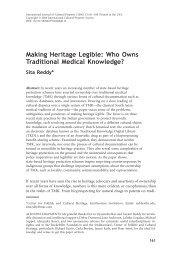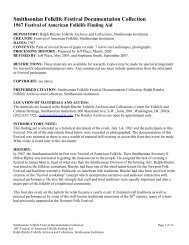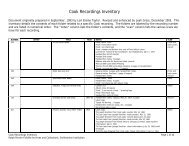Fall 2005 - Smithsonian Center for Folklife and Cultural Heritage
Fall 2005 - Smithsonian Center for Folklife and Cultural Heritage
Fall 2005 - Smithsonian Center for Folklife and Cultural Heritage
Create successful ePaper yourself
Turn your PDF publications into a flip-book with our unique Google optimized e-Paper software.
2 0 0 5 S M I T H S O N I A N F O L K L I F E F E S T I V A L<br />
F o o d C u l t u r e U S A<br />
b y S T E P H E N K I D D , P R O G R A M C O - C U R A T O R<br />
Food Culture USA—the Festival’s first full program<br />
devoted to foodways—explored the intersections<br />
between tradition, innovation, commerce, <strong>and</strong> culture.<br />
The program was built on the foundation of years of<br />
research conducted by guest curator Joan Nathan. With<br />
over 400 participants, the program focused on what we<br />
called the Food Revolution of the last 40 years by exploring<br />
three trends evident in the United States over that<br />
period: the increased diversity of American food; the<br />
grassroots movement <strong>for</strong> sustainability; <strong>and</strong> the ef<strong>for</strong>ts of<br />
chefs, cookbook writers, <strong>and</strong> educators to discover <strong>and</strong><br />
pass on the roots of their food traditions.<br />
The Edible Schoolyard—a 12,000-square-foot garden<br />
planted in the middle of the National Mall—was an<br />
East Coast version of Alice Waters’s Edible Schoolyard in<br />
Berkeley, Cali<strong>for</strong>nia. Festival visitors strolled through beds of<br />
greens, tomatoes, beans, <strong>and</strong> even artichokes, while teachers<br />
from Berkeley <strong>and</strong> Washington, D.C., led visitors on tours<br />
of the garden, <strong>and</strong> narrative sessions focused on school programs<br />
<strong>and</strong> nutrition in the garden’s circular Ramada.<br />
The Garden Kitchen, Home Cooking, <strong>and</strong> Beyond<br />
the Melting Pot were continuously programmed with professional<br />
chefs <strong>and</strong> home cooks from around the country.<br />
KitchenAid generously loaned the Festival three beautiful<br />
demonstration kitchens in which participants Mark<br />
Federman <strong>and</strong> Herman Vargas of Manhattan’s Russ <strong>and</strong><br />
Daughters sliced their smoked fish; Paul Prudhomme<br />
discussed the roots of his cooking in the traditions of<br />
Louisiana; <strong>and</strong> Gilroy <strong>and</strong> Sally Chow of Mississippi stirfried<br />
in their home-engineered propane wok.<br />
In the Global Exchange area Vann’s Spices <strong>and</strong><br />
Honest Tea talked about sourcing spices <strong>and</strong> tea abroad<br />
from the perspective of an American processor.<br />
Mshikamano, a coffee-growers cooperative from Tanzania<br />
led by David Robinson, son of Hall of Fame baseball<br />
player Jackie Robinson; <strong>and</strong> El Ceibo, a cacao growers<br />
<strong>and</strong> chocolate producers federation of cooperatives from<br />
Bolivia, brought the perspective of producers marketing<br />
their products in the United States.<br />
The Local to National area explored transitions from<br />
small, locally based producers to larger, nationally oriented<br />
companies. Horizon Organics presented its system of<br />
national distribution <strong>and</strong> marketing of milk produced by<br />
independently owned dairy farms across the country. Silk<br />
Soy—which got its start selling tofu at a farmers market in<br />
Colorado—brought tofu-making equipment to the Mall.<br />
PHOTO BY CAROLE DOUGLIS, SMITHSONIAN INSTITUTION<br />
An array of growers displayed produce, discussed the<br />
traditions they support, <strong>and</strong> demonstrated growing techniques<br />
in the Tradition <strong>and</strong> Adaptation area.<br />
In the Technology area visitors could browse through<br />
kitchen gadgets <strong>and</strong> utensils at the Tools of the Trade tent<br />
or see students from the Culinary Institute of America<br />
demonstrating the skills <strong>and</strong> roles used in restaurants in<br />
the Professional Kitchen. The Food Safety <strong>and</strong> Quality tent<br />
brought together inspectors from the U.S. Department of<br />
Agriculture’s Agriculture Marketing Service <strong>and</strong> Food Safety<br />
Inspection Service with experts from the D.C. Department<br />
of Public Health, the Restaurant Association of Metropolitan<br />
Washington, <strong>and</strong> the National Restaurant Association.<br />
Slow Roast featured a series of day-long cooking<br />
demonstrations <strong>and</strong> food celebrations. Two barbecue<br />
experts, Jim Tabb of Tryon, North Carolina, <strong>and</strong> Mike<br />
Mills of southern Illinois, brought their rigs to the Mall.<br />
Participants from El Patio restaurant demonstrated<br />
Argentinean urban <strong>and</strong> rural barbecue with a traditional<br />
asado. Members of the Norbeck Community Church with<br />
Reverend Courtenay Miller <strong>and</strong> cookbook author Brenda<br />
Rhodes Miller led a Dinner on the Grounds. And the<br />
Ghanem family held a Middle East lamb roast.<br />
Food Culture USA’s diverse group of participants<br />
explored the traditional underpinnings of the contemporary<br />
trans<strong>for</strong>mation of the American food l<strong>and</strong>scape.<br />
This intersection of change <strong>and</strong> tradition proved a fruitful<br />
vein of inquiry at a time of tremendous enthusiasm<br />
about American foodways.<br />
■<br />
Visitors to the Food Culture USA program examine a<br />
bed of tomatoes while others participate in a narrative<br />
session in the Ramada at the Edible Schoolyard.<br />
{ 3 }<br />
F A L L 2 0 0 5



